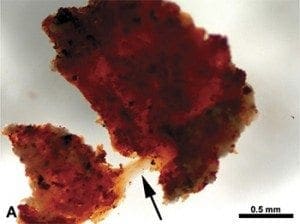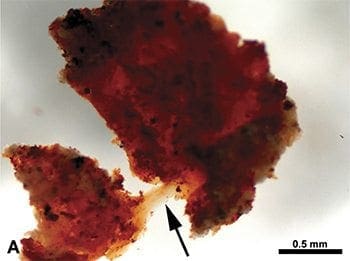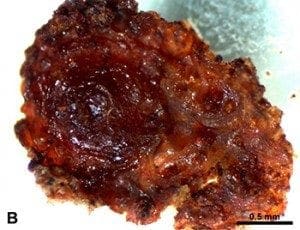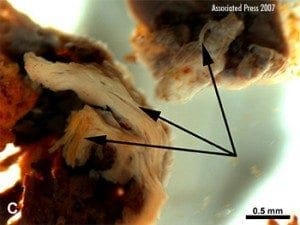Allegedly, “no human being has ever seen a live dinosaur” (“Age…,” 1993, 183[1]:142). Evolutionary scientists insist that dinosaurs became extinct 60+ million years ago, while humans evolved approximately 57 million years later. Regardless of ubiquitous, ancient stories and artifacts that indicate man once coexisted with dinosaurs (see Butt and Lyons, 2005; Lyons, 2007), evolutionists continue to put their confidence in assumption-based dating methods, declaring dinosaur fossils to be many millions of years older than man or monkey. More and more evidence is coming to light, however, which casts serious doubt on evolutionists’ claims.
In March 2005, “paleontologists were stunned to find that the soft tissue of a…dinosaur was preserved within a fossil from a Tyrannosaurus rex” (Boyle, 2007, emp. added). Dr. Mary Schweitzer and her colleagues reported the find in Science magazine, describing the demineralized T. rex femur and tibia fragments as “highly fibrous,” “flexible,” and so “resilient” that “when stretched, returns to its original shape” (Schweitzer, et al., 2005, 307:1952,1953; Schweitzer, et al., 2007, 316:277). Amazingly, the researchers were even able to squeeze round, dark-red-to-deep-brown microscopic structures from the presumed T. rex blood vessels (Perkins, 2005, 167[13]:195). Scientists were shocked! “Such a thing had never been seen before” (Boyle, 2007). How could a “70-million-year-old” Tyrannosaurus rex bone still contain soft tissue?

For those who may chalk this up as just some anomaly that should cast no doubt upon the multi-million-year evolutionary timetable, consider what MSNBC science editor Alan Boyle reported on July 24, 2007: “Today, paleontologists are still stunned—not only to find material that looks like dinosaur cartilage, blood vessels, blood cells and bone cells, but to see the stuff in so many different specimens” (emp. added). Paleontologist Kristi Rogers of Macalester College said: “It’s not just a fluke occurrence…. It’s something that’s more pervasive in the fossil record” (as quoted in Boyle). Scientists have excavated a Tyrannosaurus and a hadrosaur from Montana, a Titanosaurus from Madagascar, and more samples that the famous dinosaur fossil hunter Jack Horner has uncovered in Montana, as well as Mongolia. Regarding the hadrosaur specimen found in Montana, Dr. Mary Schweitzer stated: “It’s the ‘freshest,’ if you will, dinosaur bone that has ever had this analysis conducted on it” (as quoted in Boyle).
Although evolutionists continue to describe such dinosaur bones as “70 million years old,” “miraculously preserved soft tissue” (Gebel, 2007) in a “growing number of tissue samples” (Boyle, 2007) around the world demands a reasonable explanation. Suggesting that these bones sat around for at least 70 million years (or 25.55 billion days) in “porous sandstone” (Morris, n.d.) without completely fossilizing or decomposing literally is unbelievable. A much better, more logical explanation is that dinosaurs once lived on Earth in the not-too-distant past—only a few hundred or thousand years ago, not 60+ million years ago. If soft, flexible, resilient, highly fibrous dinosaur tissue in many different specimens will not convince the gainsayer, what would?
REFERENCES
“Age of Dinosaurs” (1993), National Geographic, 183[1]:142, January.
Boyle, Alan (2007), “Finding a Dinosaur’s Soft Spots,” MSNBC, [On-line], URL: http://cosmiclog.msnbc.msn.com/archive/2007/07/24/288786.aspx.
Butt, Kyle and Eric Lyons (2005), “A Trip Out West—To See the Dinosaurs,” Resources, 4[3]:9R-11R, March, [On-line], URL: http://www.apologeticspress.org/articles/2705.
Gebel, Erika (2007), “T. Rex May Be Close Relation to the Chicken,” Charleston Daily Mail, April 16, [On-line], URL: http://www.dailymail.com/story/Life/2007041620/T-Rex-may-be-close- relation-to-the-chicken/.
Lyons, Eric (2007), “Historical Support for the Coexistence of Dinosaurs and Humans—Part I & II,” Reason & Revelation, 27:65-71,73-79, September & October.
Morris, John (no date), “Dinosaur Soft Parts,” Institute for Creation Research, [On-line], URL: http://www.icr.org/article/2032/.
Perkins, Sid (2005), “Old Softy: Tyrannosaurus Fossil Yields Flexible Tissue,” Science News, 167[13]:195, March 26, [On-line], URL: http://www.sciencenews.org/articles/20050326/fob1.asp.
Schweitzer, Mary H., Jennifer L. Wittmeyer, John R. Horner, and Jan K. Toporski (2005), “Soft-Tissue Vessels and Cellular Preservation in Tyrannosaurus rex,” Science, 307:1952-1955, March 25.
Schweitzer, Mary, et al. (2007), “Analyses of Soft Tissue from Tyrannosaurus rex Suggest the Presence of Protein,” Science, 316:277-285, April 13.








Truth of this will never hit mainstream media!
Too bad. Satan and his minions will cover it up and mock.